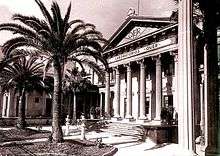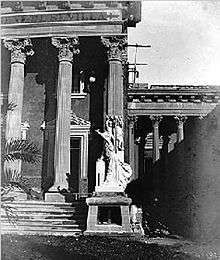Instituto de Higiene del Doctor Murga
The Instituto de Higiene del Doctor Murga (English for: Institute of Hygiene of the Doctor Murga) was a Neoclassical building, it was on the calle Marqués de Paradas nº 35, in Seville, near the former station of Córdoba, and belonged to Dr. Leopoldo Murga Machado, founder of the Institute of Hygiene.



This building, with vocation of Roman temple, inspired in the British Museum, was built between 1905-1907 by the architect Francisco Franco Pineda as residence, clinic, laboratory and scientific agencies of the Dr. Murga, who ordered its construction as private initiative.[1]
It had quite popular among the Sevillan elite of the time, as a dip in the institute came the cheap cost the price of one peseta.[2]
Description
The central nave was dedicated to works of laboratory, bacteriology and cabinet of consultations. In the pavilion on the left it was installed the electrotherapy center, and the pavilion on the right, the hydrotherapy section. Provided of fourteen bathrooms, two of them luxury.
The garden of the building was flanked by sculptures referring to allegories of hygiene and the bathrooms. These sculptures, made of stone, were work by Adolfo López Rodriguez, Sevillian sculptor of the early 20th century. In addition to these allegories, López also performed for Seville the statue of Archbishop D.Remondo (1923) for the pedestal of the monument to Saint Ferdinand, in the Plaza Nueva; in artificial stone (or colored cement) and the statue of Francisco Pizarro, for the front garden for the missing Fountain de los Conquistadores of the Ibero-American Exposition of 1929.
Destruction
Since its closure in 1938 (during the Spanish Civil War) was completely abandoned until its demolition was ordered in 1958, without even mentioning its restoration to adapt to other uses. Not even were preserved the sculptures in its garden, which were destroyed in the demolition. Instead was built a new health center.
The current clinic, which occupies the site of the building was by architect Fernando García Mercadal should and was built between the late 1960s-70s. This new building, of simple lines, is a functional building, very similar to other outpatient built at that time, like those of María Auxiliadora or of the calle J. de Padilla, the same architect.
References
- Maquinadepiquetas. "Derribos De". Derribosdesevilla.blogspot.com. Retrieved 2016-03-13.
- David M Luna. "Palabras Al Vacio: Sevilla Perdida Iii: Instituto De Higiene Del Doctor Murga". Dmluna.blogspot.com. Retrieved 2016-03-13.
| Wikimedia Commons has media related to Instituto de Higiene del Doctor Murga. |